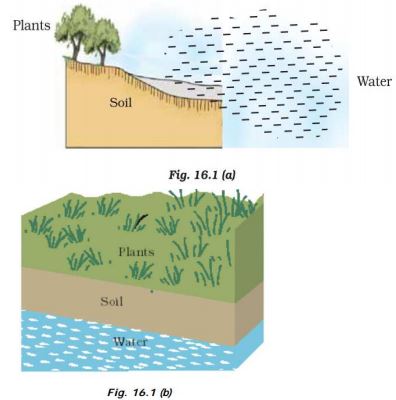NCERT Solution: Management of Natural Resources

(a) Locate and name the water reservoirs in Figures 16.1 (a) and (b).
Ans. The water reservoir is a pond in Figure 16.1 (a) and underground water body in the Figure 16.1 (b).
(b) Which has an advantage over the other and why?
Ans. Figure 16.1 (b) has more advantage than Figure 16.1 (a), because the advantages of water stored in the ground are many. For example
(a) It does not evaporate
(b) It spreads out to recharge wells.
(c) Provides moisture for vegetation over a wide area.
(d) It is protected from contamination by animal and human wastes.
(e) It prevents breeding of insects.
Reduce means to use a material/commodity in lesser quantity, e.g electricity and water
Recycle means a material that is used once is collected and sent back to a manufacturer so that they can make some other useful material from it:
e.g., plastic cups and buckets, glass tumbler, paper, metal objects
Reuse means using a thing over and over again instead of throwing it away. It does not involve the process of recycling either in small or large scale: e.g., used envelopes, plastic carry bags, bottles of jam.
(a) Unused water in the water bottle may be used for watering plant
(b) Close all the taps before you go to sleep.
(c) Avoid using a hose pipe for watering plants
(d) Wash vehicles only when they are dirty
(e) Use fan and light only when required
(f) Use solar water heating devices
(g) Use CFL in place of conventional bulbs/tubes
Water is essential for all living beings. About 70% of our body weight is composed of water. we cannot survive without water because water is required for all biological activities. This shows the importance of water for life. The earth has plenty of water. But most of this water is available in the form of saline water which is not fit for our use. Less than 1% of total water on earth is available as drinking water. This shows that water is precious for us. Due to growing population, we are using water like never before. At many places, people are overexploiting water resources. Due to this, people at most of the places are suffering from acute shortage of water. In the context of above scenario, it can be said that water conservation is necessary.
Waste water can be used for
(a) recharging the ground water
(b) can be used for irrigation
(c) treated municipal water can be used for washing cars, watering the gardens
(c) certain pollutants in sewage water can become fertilizer for various crops.
Forests are renewable resources which provide
(a) Habitat, food, protection to wild life.
(b) Help in balancing CO2 and O2 of atmosphere.
(c) Improves water holding capacity of soil.
(d) Regulates water cycle.
(e) For human being, they are the source for all essential commodities like, fuel wood, timber pulp and paper etc.
(f) It provides useful products like fruits, resins, gums, essential oils, bidi wrapper etc.
Arabari forest range is present in Midnapore district of West Bengal. Sal is the main tree in this forest. During 1970s, the sal forest was in a state of decline in this forest. The officials of the West Bengal Forest Department analysed the situation. They found that alienation of local people from forest management was the main reason for the pathetic situation. Most of the local inhabitants depend on forest for their sustenance. If they are debarred from entering the forests, they would be robbed off their main source of sustenance. This will make the people feel alienated. This was major reason for many people taking up arms to get involved in Naxalite movement. A forest officer with great foresight joined Arabari. His name was A.K Banerjee. He gave the responsibility of managing 1,272 hectares of sal forest to local people. This forest was badly degraded. In lieu of managing the forest, the people were given 25% in final harvest. They were also allowed to collect firewood and fodder against a nominal fee. This helped in ensuring people’s involvement in forest management. This changed the fortune of the Arabari forest. The sal forest was a worthless degraded forest before implementation of programme by A.k. Banerjee. But after that, the value of sal in the forest reached ₹12.5 crores by 1983. The above story shows why the Arabari forest is taken as good example of forest conservation.